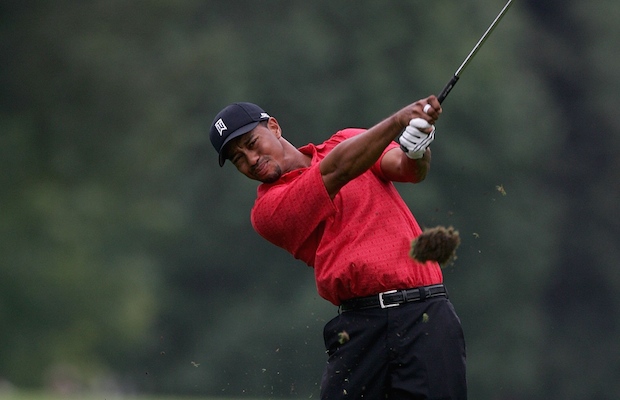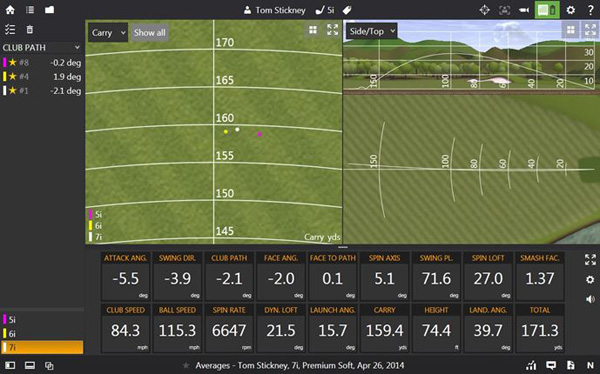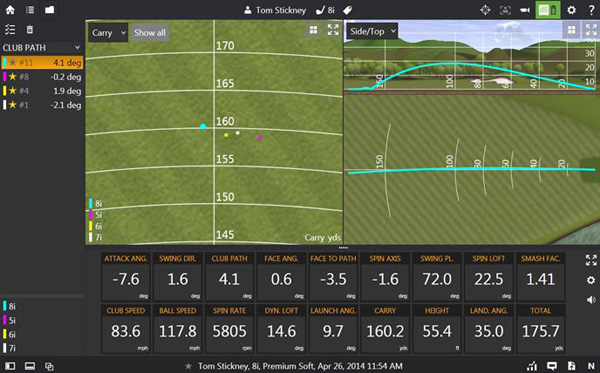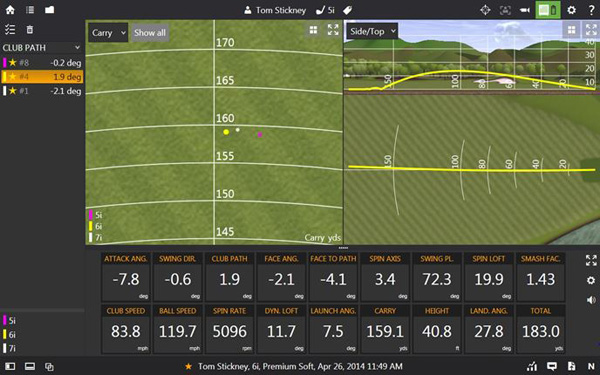Instruction
Examining the best ways to hit lower-flying shots

On a windy day here in Southern California, I was goofing around on the Trackman before one of my lessons hitting the ball higher, lower, curving it, etc. I love seeing what the numbers do as I hit different shots, but that day I was focused on hitting the ball lower because of the wind.
I’ve always taught different players different ways to hit the ball lower based on their ability levels, which is something I still do to this day. I thought it might be fun, however, to hit several different low shots on my Trackman and see how the numbers turn out. To put myself to the test, I hit three different clubs with three different swings, each of which flew pretty close to the same distance. The shots were:
- A stock 7 iron.
- A 7 iron “knockdown.”
- A 6 iron “knockdown.”
- An “easy” 5 iron.
1. A Stock 7 Iron
- Angle of attack: -5.5 degrees
- Club head speed: 84.3 mph
- Ball speed: 115 mph
- Spin: 6647 rpm
- Dynamic Loft: 21.5 degrees
- Launch angle: 15.7 degrees
- Peak height: 74.4 feet
- Landing Angle: 39.7 degrees
- Carry: 159.4 yards
- Total: 171.3 yards
2. A 7 Iron Knockdown
- Angle of attack: -7.6 degrees
- Club head speed: 83.6 mph
- Ball speed: 117.8 mph
- Spin: 5805 rpm
- Dynamic Loft: 14.6 degrees
- Launch angle: 9.7 degrees
- Peak height: 55.4 feet
- Landing Angle: 35 degrees
- Carry: 160.2 yards
- Total: 175.7 yards
3. A 6 Iron Knockdown
- Angle of attack: -7.8 degrees
- Club head speed: 83.6 mph
- Ball speed: 119.7 mph
- Spin: 5096 rpm
- Dynamic Loft: 11.7 degrees
- Launch angle: 7.5 degrees
- Peak height: 40.8 feet
- Landing Angle: 27.8 degrees
- Carry: 159.1 yards
- Total: 183 yards
4. An Easy 5 Iron
- Angle of attack: -5.6 degrees
- Club head speed: 85.1 mph
- Ball speed: 114.7 mph
- Spin: 4354 rpm
- Dynamic Loft: 15.5 degrees
- Launch angle: 11.7 degrees
- Peak height: 49.6 feet
- Landing Angle: 30.7 degrees
- Carry: 158.8 yards
- Total: 181.8 yards
What does this all mean?
The goal of this exercise was to show how angle of attack, dynamic loft and trajectory work together. As the angle of attack becomes more downward, dynamic loft, or the amount of loft the club face has at impact, tends to decrease. That’s why golfers have to be mindful of their dynamic loft at impact, as it can change how far the ball carries and what it does when it hits the ground.
When golfers are trying to hit low shots, it’s sometimes better to use the same club they would use for a full shot, while other times it’s better to use a longer club for the same carry distance.
For these four different shots, my carry ranges were between 158.8 yards and to 160.2 yards, which is pretty much the same. The key to choosing the best shot depends on what you would like you ball to do when it lands. As the height decreases, so does the ball’s landing angle, making the ball roll out farther.
My spin rates in this exercises ranged from 4,354 rpm with an easy 5 iron (the lowest-spinning shot) to 6,647 rpm with a full 7 iron (my highest spinning shot). The more spin a shot has, the quicker it will stop, especially if the landing angles are similar.
Choosing the right shot
Pin back, lots of room in front: If you have a pin that’s located on the back of the green and there is plenty of room in front of the pin for the ball to release, it might be best to use a less-lofted club and make an easy swing like I did with my easy 5 iron. This shot should chase forward more easily than a shot hit with the same club and swung harder, or a higher-lofted club.
Pin on back shelf, lots of wind: If you have a pin on the back shelf, but you need to hit the ball low because of the wind and still want the shot to have close-to-normal spin, you should choose the same club and hit the knockdown shot as I did with my 7 iron knockdown. My 7 iron knockdown flew about 20 feet lower than my stock 7 iron, because it launched lower and had less spin. That helps keep it out of the wind.
When a lower-trajectory is needed: Choosing one club more and knocking it down will give golfers an even lower, flatter trajectory with some spin and some run, but not too much of either. This is the best choice for the “stock” low shot most golfers like to hit.
Take your time when you’re practicing and when you’re choosing the best shot on the course to understand that there are four different ways to hit the ball when the wind is blowing:
- Use your stock shot.
- Use the same club, but hit it lower.
- Use one more club, but hit it a touch lower.
- Use two more clubs, but make an easier swing.
All shots will react differently, so it’s up to you to figure out which works best for your game. It can be one, some or all of these shots depending on how you want it to react when it hits the green.
- LIKE5
- LEGIT0
- WOW1
- LOL0
- IDHT0
- FLOP0
- OB0
- SHANK0
Instruction
Clement: Laid-off or perfect fade? Across-the-line or perfect draw?

Some call the image on the left laid off, but if you are hitting a fade, this could be a perfect backswing for it! Same for across the line for a draw! Stop racking your brain with perceived mistakes and simply match backswing to shot shape!
- LIKE0
- LEGIT0
- WOW0
- LOL0
- IDHT0
- FLOP0
- OB0
- SHANK1
Instruction
The Wedge Guy: The easiest-to-learn golf basic

My golf learning began with this simple fact – if you don’t have a fundamentally sound hold on the golf club, it is practically impossible for your body to execute a fundamentally sound golf swing. I’m still a big believer that the golf swing is much easier to execute if you begin with the proper hold on the club.
As you might imagine, I come into contact with hundreds of golfers of all skill levels. And it is very rare to see a good player with a bad hold on the golf club. There are some exceptions, for sure, but they are very few and very far between, and they typically have beat so many balls with their poor grip that they’ve found a way to work around it.
The reality of biophysics is that the body moves only in certain ways – and the particulars of the way you hold the golf club can totally prevent a sound swing motion that allows the club to release properly through the impact zone. The wonderful thing is that anyone can learn how to put a fundamentally sound hold on the golf club, and you can practice it anywhere your hands are not otherwise engaged, like watching TV or just sitting and relaxing.
Whether you prefer an overlap, interlock or full-finger (not baseball!) grip on the club, the same fundamentals apply. Here are the major grip faults I see most often, in the order of the frequency:
Mis-aligned hands
By this I mean that the palms of the two hands are not parallel to each other. Too many golfers have a weak left hand and strong right, or vice versa. The easiest way to learn how to hold the club with your palms aligned properly is to grip a plain wooden ruler or yardstick. It forces the hands to align properly and shows you how that feels. If you grip and re-grip a yardstick several times, then grip a club, you’ll see that the learning curve is almost immediate.
The position of the grip in the upper/left hand
I also observe many golfers who have the butt of the grip too far into the heel pad of the upper hand (the left hand for right-handed players). It’s amazing how much easier it is to release the club through the ball if even 1/4-1/2″ of the butt is beyond the left heel pad. Try this yourself to see what I mean. Swing the club freely with just your left hand and notice the difference in its release from when you hold it at the end of the grip, versus gripping down even a half inch.
To help you really understand how this works, go to the range and hit shots with your five-iron gripped down a full inch to make the club the same length as your seven-iron. You will probably see an amazing shot shape difference, and likely not see as much distance loss as you would expect.
Too much lower (right) hand on the club
It seems like almost all golfers of 8-10 handicap or higher have the club too far into the palm of the lower hand, because that feels “good” if you are trying to control the path of the clubhead to the ball. But the golf swing is not an effort to hit at the ball – it is a swing of the club. The proper hold on the club has the grip underneath the pad at the base of the fingers. This will likely feel “weak” to you — like you cannot control the club like that. EXACTLY. You should not be trying to control the club with your lower/master hand.
Gripping too tightly
Nearly all golfers hold the club too tightly, which tenses up the forearms and prevents a proper release of the club through impact. In order for the club to move back and through properly, you must feel that the club is controlled by the last three fingers of the upper hand, and the middle two fingers of the lower hand. If you engage your thumbs and forefingers in “holding” the club, the result will almost always be a grip that is too tight. Try this for yourself. Hold the club in your upper hand only, and squeeze firmly with just the last three fingers, with the forefinger and thumb off the club entirely. You have good control, but your forearms are not tense. Then begin to squeeze down with your thumb and forefinger and observe the tensing of the entire forearm. This is the way we are made, so the key to preventing tenseness in the arms is to hold the club very lightly with the “pinchers” — the thumbs and forefingers.
So, those are what I believe are the four fundamentals of a good grip. Anyone can learn them in their home or office very quickly. There is no easier way to improve your ball striking consistency and add distance than giving more attention to the way you hold the golf club.
More from the Wedge Guy
- The Wedge Guy: Golf mastery begins with your wedge game
- The Wedge Guy: Why golf is 20 times harder than brain surgery
- The Wedge Guy: Musings on the golf ball rollback
- LIKE86
- LEGIT13
- WOW6
- LOL1
- IDHT0
- FLOP4
- OB1
- SHANK8
Instruction
Clement: Stop ripping off your swing with this drill!

Not the dreaded headcover under the armpit drill! As if your body is defective and can’t function by itself! Have you seen how incredible the human machine is with all the incredible feats of agility all kinds of athletes are accomplishing? You think your body is so defective (the good Lord is laughing his head off at you) that it needs a headcover tucked under the armpit so you can swing like T-Rex?
- LIKE0
- LEGIT2
- WOW2
- LOL0
- IDHT0
- FLOP0
- OB0
- SHANK2
-

 19th Hole2 weeks ago
19th Hole2 weeks agoDave Portnoy places monstrous outright bet for the 2024 Masters
-

 19th Hole3 days ago
19th Hole3 days agoJustin Thomas on the equipment choice of Scottie Scheffler that he thinks is ‘weird’
-

 19th Hole2 weeks ago
19th Hole2 weeks agoTiger Woods arrives at 2024 Masters equipped with a putter that may surprise you
-

 19th Hole3 days ago
19th Hole3 days ago‘Absolutely crazy’ – Major champ lays into Patrick Cantlay over his decision on final hole of RBC Heritage
-

 19th Hole2 weeks ago
19th Hole2 weeks agoTwo star names reportedly blanked Jon Rahm all week at the Masters
-

 19th Hole1 week ago
19th Hole1 week agoReport: LIV Golf identifies latest star name they hope to sign to breakaway tour
-

 19th Hole1 week ago
19th Hole1 week agoNeal Shipley presser ends in awkward fashion after reporter claims Tiger handed him note on 8th fairway
-

 19th Hole1 week ago
19th Hole1 week agoBrandel Chamblee has ‘no doubt’ who started the McIlroy/LIV rumor and why




















matt
Jun 4, 2014 at 11:02 am
Great article…any tips for simple set-up and execution of the four different shots? I struggle with keeping it low.
Tom Stickney
Jun 5, 2014 at 10:36 pm
See my youtube channel for videos on this. Many different ways to do it. http://www.youtube.com/tomstickneygolf
TJ
Jun 4, 2014 at 9:03 am
Great more to think about when playing golf… ha
great article through I will have to put some more thought into my next round depending on pin placement if the wind is up.
tom stickney
Jun 4, 2014 at 8:02 pm
Golf is SO cerebral….
Bill
Jun 4, 2014 at 8:27 am
In your experience with launch monitor data, how do stiff headwinds (25+mph) affect carry distances with drivers and irons? With today’s lower spin drivers, some teachers advocate hitting your normal high launch tee shot even into the wind. Does launch monitor data support this or should you try and flight the ball down into a stiff headwind? Thanks
tom stickney
Jun 4, 2014 at 8:01 pm
It all depends on the player…sometimes hitting the high launching ball with little spin is much better than trying to hit it on a lower trajectory when the miss (when you try to hit it low) is chopping down and spinning the ball even more. Some players hit flat rockets that hit and run, but that also has it’s limitations on the conditions of the golf course. You’ll have to get on a launch monitor and experiment.
paul
Jun 3, 2014 at 11:34 pm
Interesting, going to experiment with a laser next range session. Love your articles.
tom stickney
Jun 4, 2014 at 7:58 pm
Thank you Paul; I try…
Rip
Jun 3, 2014 at 7:58 pm
Peak height 74 feet. Your stock shot is kind of a knock down as it is….
Tom Stickney
Jun 3, 2014 at 10:17 pm
Growing up on the fla coast does that to a player…
tom stickney
Jun 3, 2014 at 5:25 pm
Tim– My shot was a touch thin giving me the flatter landing angle. This shot would have moved basically dead straight- a touch left of the target based on the face to path numbers being just about the same. Just a touch heeled- a 5.1 spin axis. Usual for my first few swings of the day…
tinytim
Jun 4, 2014 at 4:44 am
all good 🙂
tinytim
Jun 3, 2014 at 3:51 pm
stock 7iron, coming down with less as 40° is a real poor ballflight. that will roll over any green. but i like the 7i knockdown. i might say, the stockshot wasnt center face contact, since its really fading when based on path/face it should go damn pulled left.